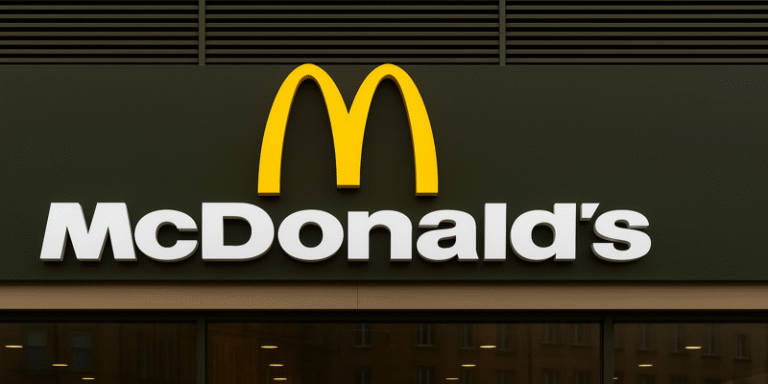McDonald’s is not just a fast-food chain; it is a symbol of globalisation, capitalism, and modern consumer culture. From its humble beginnings as a small drive-in restaurant in San Bernardino, California, McDonald’s has grown into one of the most recognisable brands in the world. With over 40,000 locations in more than 100 countries, McDonald’s has reshaped global food culture, introduced revolutionary business practices, and sparked debates on health, sustainability, and labour.
A Brief History
The origins of McDonald’s can be traced back to 1940, when brothers Richard and Maurice McDonald opened the first McDonald’s restaurant in California. They introduced the “Speedee Service System” in 1948, which revolutionised the food industry by implementing a production line model to deliver food quickly and efficiently (Ritzer, 2011). Ray Kroc, a milkshake machine salesman, saw the potential in their operation and in 1955, he opened the first franchised McDonald’s in Des Plaines, Illinois. By buying out the brothers in 1961, Kroc laid the foundation for the McDonald’s Corporation as we know it today (Love, 1995).
Business Model and Global Expansion
McDonald’s success is largely attributed to its franchising model. Approximately 93% of McDonald’s restaurants are operated by independent franchisees (McDonald’s Corporation, 2023). This model allows for rapid expansion while maintaining consistent branding and product standards across locations. McDonald’s standardises its core offerings like the Big Mac and Chicken McNuggets, while also adapting menus to local tastes—for example, offering McSpaghetti in the Philippines and McAloo Tikki in India (Watson, 2006).
The brand’s international expansion has been strategic. In each country, McDonald’s studies local eating habits, partners with local suppliers, and often presents itself as a family-friendly, community-oriented business. As a result, it has become both a symbol of American culture and a localised brand in many regions (Ritzer, 2011).
Cultural Impact and the “McDonaldisation” Thesis
Sociologist George Ritzer coined the term “McDonaldisation” to describe the process by which the principles of fast-food restaurants—efficiency, calculability, predictability, and control—come to dominate other sectors of society (Ritzer, 2011). This concept highlights how McDonald’s is more than a food outlet; it is a cultural force that influences work, education, healthcare, and even relationships.
Critics argue that McDonaldisation leads to homogenisation of culture, loss of human interaction, and the prioritisation of quantity over quality (Smart, 2010). Yet, others view it as a symbol of modern convenience and consumer choice.
Health and Nutrition Controversies
Despite its popularity, McDonald’s has faced significant criticism over its contribution to rising obesity rates, particularly in the West. Fast food is often high in calories, saturated fats, and sodium, contributing to poor health outcomes (Schlosser, 2001). The 2004 documentary Super Size Me by Morgan Spurlock brought this issue into mainstream public discourse, showing the adverse health effects of eating only McDonald’s food for 30 days.
In response to public pressure and changing consumer preferences, McDonald’s has introduced healthier options such as salads, fruit, and low-fat milk, and added nutritional information to packaging and menus (McDonald’s Corporation, 2023). However, sceptics argue these changes are more about public relations than a genuine shift in business ethics (Nestle, 2013).
Sustainability and Environmental Concerns
Another area of controversy is McDonald’s environmental impact. The fast-food industry is a major contributor to greenhouse gas emissions, deforestation (especially for beef production), and plastic waste. In 2018, McDonald’s announced plans to make 100% of its packaging from renewable, recycled, or certified sources by 2025 (McDonald’s, 2018).
The company has made efforts to reduce its carbon footprint by sourcing sustainable beef, using energy-efficient appliances, and supporting recycling initiatives. Still, environmental groups argue that these steps are not sufficient given the scale of the brand’s operations (Greenpeace, 2022).
Labour Practices and Employment
McDonald’s is one of the world’s largest employers, with over 1.9 million workers globally (Statista, 2024). It is often a first job for many young people, offering flexible hours and basic training. However, it has also been criticised for low wages, limited career advancement, and poor working conditions.
The “Fight for $15” movement, which began in the United States, calls for higher wages and union rights for fast-food workers, including McDonald’s employees. While some countries have stronger labour protections, critics argue that McDonald’s benefits from and reinforces precarious employment practices globally (Taylor, 2020).
Innovation and Digital Transformation
To stay competitive in a changing marketplace, McDonald’s has embraced digital innovation. Mobile ordering, touch-screen kiosks, and delivery partnerships with Uber Eats and DoorDash have transformed how customers interact with the brand. The introduction of the MyMcDonald’s Rewards app reflects a broader trend toward data-driven marketing and personalised customer experiences (Forbes, 2022).
In 2019, McDonald’s acquired Dynamic Yield, a tech company that uses artificial intelligence to customise digital menus based on time of day, weather, and customer behaviour (McDonald’s Corporation, 2019). These innovations aim to increase efficiency and appeal to tech-savvy consumers.
McDonald’s is more than a fast-food restaurant; it is a cultural, economic, and technological phenomenon. While it has been praised for innovation and global reach, it has also been a lightning rod for criticism regarding health, environment, and labour. The brand’s ability to evolve while retaining its core identity is a key reason for its enduring success. As consumer preferences shift towards healthier, more sustainable options, the future of McDonald’s will depend on its ability to adapt without losing the qualities that made it a global icon.
References
Forbes (2022) McDonald’s Digital Transformation: AI and Customer Experience. [online] Available at: https://www.forbes.com [Accessed 24 Jul. 2025].
Greenpeace (2022) Big Food’s Greenwashing: A Deep Dive into McDonald’s Sustainability Claims. [online] Available at: https://www.greenpeace.org [Accessed 24 Jul. 2025].
Love, J.F. (1995) McDonald’s: Behind the Arches. New York: Bantam.
McDonald’s Corporation (2018) Packaging and Recycling Goals. [online] Available at: https://corporate.mcdonalds.com [Accessed 24 Jul. 2025].
McDonald’s Corporation (2019) McDonald’s Acquires Dynamic Yield. [online] Available at: https://corporate.mcdonalds.com [Accessed 24 Jul. 2025].
McDonald’s Corporation (2023) Annual Report 2023. [online] Available at: https://corporate.mcdonalds.com [Accessed 24 Jul. 2025].
Nestle, M. (2013) Food Politics: How the Food Industry Influences Nutrition and Health. Berkeley: University of California Press.
Ritzer, G. (2011) The McDonaldization of Society. 6th ed. Los Angeles: SAGE Publications.
Schlosser, E. (2001) Fast Food Nation: The Dark Side of the All-American Meal. Boston: Houghton Mifflin.
Smart, B. (2010) Consumer Society: Critical Issues and Environmental Consequences. London: SAGE Publications.
Statista (2024) Number of Employees at McDonald’s Worldwide from 2005 to 2023. [online] Available at: https://www.statista.com [Accessed 24 Jul. 2025].
Taylor, K. (2020) The McDonald’s Labour Debate: Fast Food Workers and the Fight for Rights. Journal of Labour Research, 41(2), pp.205–218.
Watson, J.L. (2006) Golden Arches East: McDonald’s in East Asia. 2nd ed. Stanford: Stanford University Press.









